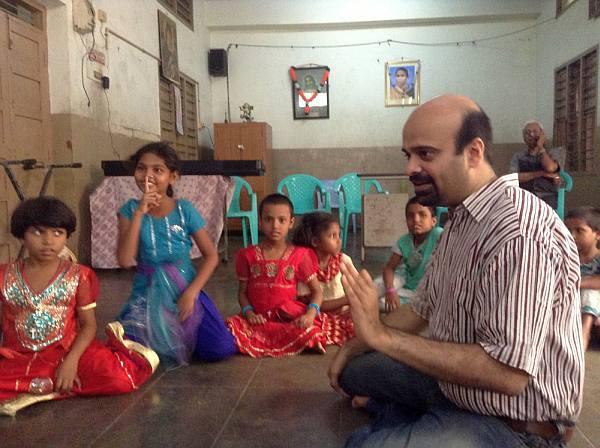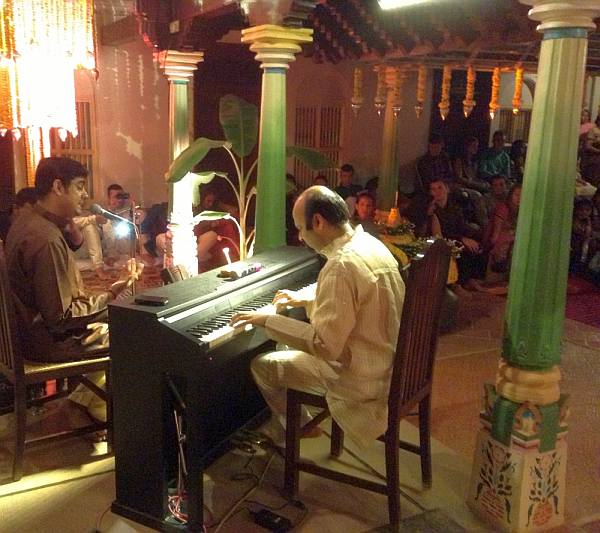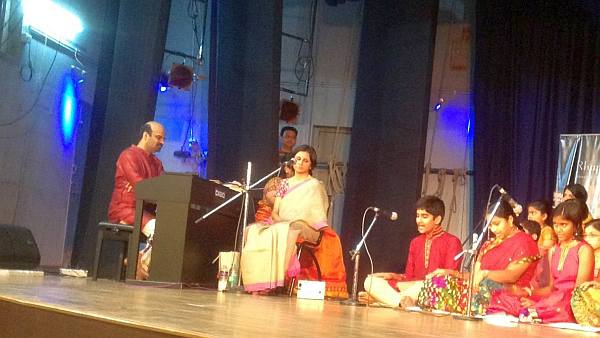
Anil Srinivasan, who started Rhapsody Music Foundation to help underprivileged children learn music, narrates how he became a classical pianist after doing a Master’s in Business Management in the US
Anil Srinivasan is a Carnatic classical pianist who has collaborated with many Indian and international artists, but there is much more to him than that.
Recently, 30 under-privileged children from Chennai's municipal schools gave a Carnatic music recital, and the man who made it possible was Srinivasan through the Rhapsody Music Foundation that he founded.
In this interview, the pianist talks about how Rhapsody came into being and how he became a classical pianist after doing a Master’s in Business Management in the US.
Introduction to music
When I was three, studying in kindergarten, I walked up to a piano in school and started playing it. That was the first time I saw a piano.
It became a big story in the school, I was told. Seeing this, Meena Radhakrishnan, the legendary Semmangudi Srinivasa Iyer's daughter-in-law, took me as her disciple and that was how I was initiated properly into music and the piano.
Perhaps I am the only person in the history of music to have gone to Semmangudi's house to learn western classical music and the piano while all the others went there to learn vaaypaattu.
I learnt piano there till the age of nine. After that, Anna Verghese became my guru for a very long time.
I don't know what attracted me to the piano; it has always been a part of my life. I believe that the instrument chooses you, and not you choose the instrument. Otherwise, at age three, how was I attracted to a piano?
Meeting the legends of Carnatic music
I still remember the swing in front of Semmangudi's house and the easy-chair in the portico. After I finished my class, I used to see him sitting there with his coffee tumbler. The moment he saw me he would ask, “What did you learn today?” Whatever I said, he would say, “Very good”. That is all I can remember of him. I was too young to have any meaningful conversation with him.
When I was 12 years old I met Lalgudi Jayaraman in Kodaikanal where his family and my family were on vacation. He taught me how to play three thillananas on the piano. He may be a violin player but he could play all the instruments.
He took me on as a student. Later, after I started working with his son and daughter, I came to know Lalgudi Mama much better.
The greatest thing about these two legends is that never once did they say, don't play the piano. They have been open and encouraging.

Bidding goodbye to music at 17
When I was 17, my father became quite ill. We went through bad times financially.
If I had to learn anything more in piano, I had to go abroad to study. Under the circumstances, that was not possible at all.
So, I had to put my musical ambitions on the back burner. It was devastating for me. I still get depressed when I think of those days.
I did my Master’s in Economics and was a University rank holder. I worked as a marketing executive in Mumbai.
There was no music in my life, and it used to kill me.
Then I went to the University of Southern California to do an MBA. 9/11 happened when I had just finished my MBA and the job market there froze. So I joined the Doctoral programme at Columbia University.
Back to music
I was in India on vacation, when I met Mandolin Srinivas and Rajesh. That resulted in me collaborating with Rajesh for the album, Into the Light.
I just couldn't believe what was happening. When I thought music had gone from my life, this happened.
That was the turning point in my life.
Another major event that happened while I was doing my PhD was meeting Aruna Sairam in New York. We jammed together at my apartment where I had a piano.
The unbelievable thing in my life is that wherever I went, somebody or the other used to gift me a piano. That is why I feel the piano came to me.
At Columbia, I spent more time in the music department and learnt music.

Meeting Sikkil Gurucharan
Early 2006 I was in Chennai. My school wanted me to compose music for a children's play. That was where I met Sikkil Gurucharan after 20 years or so.
He was six years junior to me in school. When he sang the first two notes to my music, I fell in love with his voice and I knew I had to work with him.
My life changed at that moment.
Late 2006, as I sat in a sabha listening to a kacheri of Gurucharan, I messaged my mother that I was quitting my PhD and pursuing music.
I strongly believe if I had not met Gurucharan, I would have been a marketing professor somewhere in the US.
I credit Sikkil Gurucharan for changing my life. He was the divine presence who brought me back to music. He continues to be an inspiration.
In no time, we recorded our first album, Madhirakshi and the rest is history. Fourteen years of pain was invested in that album and it appealed to a lot of people in India and abroad.
The album created so much impact that everybody started taking a look at it. I never expected this kind of response.
Madhirakshi was followed by Maaya in 2007, The Blue Divine in 2009, Tarunam in 2010 and The Story of Silk in 2012.
The great thing about Gurucharan is that he let me create and conceptualise everything.
I just wanted to introduce piano into Carnatic music. I wanted the piano to be the frame and Carnatic music, the painting. The idea of the frame was to enhance the beauty of the painting.
Later, I created more albums with musicians such as Mandolin U Srinivas, Chitrvina Ravikiran, Aruna Sairam, Unnikrishnan, Umayalpuram K Sivaraman, Lalgudi Krishnan, Anuradha Sriram Unnikrishnan, Rakesh, Chitraveena Ravi Kiran, Jayanthi Kumaresh, etc.
Perhaps to make up for lost time, I did so many collaborations in the last seven years that I sometimes feel I am on a fast track. I continued to be the frame and the others are the paintings.
But I am a reluctant painter and trying to be one by releasing Key to India, a solo album soon.

Music education through Rhapsody
I love children. I used to talk to children at various platforms. Once I was giving a talk to the children of a government school at Thiruvaroor, the birthplace of Thyagaraja. I asked them, who is the Trinity? One child got up and said, Namitha, Nayantara and Shriya Saran.
I was aghast that in a school in Thiruvaroor, kids didn't know about Carnatic music! We are so much into movies that children are ignorant about our culture and heritage, and it pained me.
Music has no importance in schools, and there are many music graduates who have no jobs. That made me think of structuring a curriculum to bring music and heritage back into the lives of children.
That was why Rhapsody Music Education Pvt Ltd was created in July 2012 as a private limited company with Rs 22 lakh. What Rhapsody does is it gets the schools to introduce music as a subject in schools and designs a curriculum. In schools that have added music class for children Rhapsody sends their own teachers to these schools.
With me was Sudhakar who had published my albums.
Sudhakar gave the space for free, so we used the money to get books printed and pay the teachers. We broke even in October 2013. In March 2014, we will touch Rs 50 lakh. It is significant for us as ours is a new start up with a new idea.
Schools responded well to the idea. From two schools two years ago, it has grown to a 100 schools in Chennai, Coimbatore, Trichy, Kumbhakonam and Bangalore. If Chennai can do this successfully, this can be replicated anywhere. Now, we have 24 music teachers working for us.
Music educator Dr Sudha Raja and I designed the curriculum and named it ‘Music and the Mind’. It is for children from Lower Kindergarten to eighth standard.
We have combined music with Mathematics, Geography, History and Science so that music can help in the holistic development of a child.
Starting Rhapsody Music Foundation to help underprivileged children
I started Rhapsody Music Foundation as a social enterprise to teach corporation school students for free. Through the Foundation, I am also working with autistic children and soon with spastic children through Vidyasagar, an NGO that works with spastic children.
Through the Agastya Foundation, Rhapsody is in 700 villages in Andhra Pradesh and Karnataka. We train the village nautankiwallahs to be teachers.
It is great fun to see the village kids take a plate and a spoon and create the Doppler effect through the Doppler song. We have created many songs for science so that children remember the concepts well.
My plan is not to take money from Rhapsody Music Education to run the Foundation, but involve like-minded people in this endeavour so that we can reach all the underprivileged children in India. I call this a community initiative and I am just a representative of the community.
I would say I have 85,000 children who are learning music through Rhapsody.
When I die, I would like a child to write my obituary about the impact of music in his or her life.